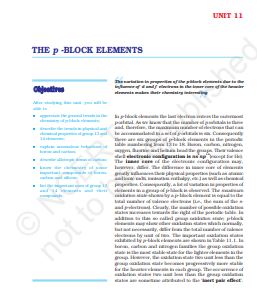‘NCERT Solutions for Class 11 Chemistry Chapter 11‘ PDF Quick download link is given at the bottom of this article. You can see the PDF demo, size of the PDF, page numbers, and direct download Free PDF of ‘Ncert Class 11 Chemistry Chapter 11 Exercise Solution’ using the download button.
NCERT Class 11 Chemistry Textbook Chapter 11 With Answer PDF Free Download

Chapter 11: p-Block Elements
11.1 Group 13 Elements: The Boron Family
This group of elements show a wide variation in properties.
Boron is a typical non-metal, aluminium is metal but shows many chemical similarities to boron, and gallium, indium and thallium are almost exclusively metallic in character.
Boron is a fairly rare element, mainly occurs as orthoboric acid, (H3BO3), borax, Na2B4O7·10H2O, and kernite, Na2B4O7·4H2O.
In India borax occurs in Puga Valley (Ladakh) and Sambhar Lake (Rajasthan). The abundance of boron in the earth’s crust is less than 0.0001% by mass. There are two isotopic forms of boron 10B (19%) and 11B (81%).
Aluminium is the most abundant metal and the third most abundant element in the earth’s crust (8.3% by mass) after oxygen (45.5%) and Si (27.7%).
Bauxite, Al2O3. 2H2O and cryolite, Na3AlF6 are the important minerals of aluminium. In India, it is found as mica in Madhya Pradesh, Karnataka, Orissa and Jammu. Gallium, indium and thallium are less abundant elements in nature.
11.1.2 Atomic Radii
On moving down the group, for each successive member one extra shell of electrons is added
and, therefore, the atomic radius is expected to increase.
However, a deviation can be seen. The atomic radius of Ga is less than that of Al. This can be understood from the variation in the inner core of the electronic configuration.
The presence of an additional 10 d-electrons offers only a poor screening effect (Unit 2) for the outer electrons from the increased nuclear charge in gallium.
Consequently, the atomic radius of gallium (135 pm) is less than that of aluminium (143 pm).
11.1.3 Ionization Enthalpy
The ionisation enthalpy values as expected from the general trends do not decrease smoothly down the group. The decrease from B to Al is associated with an increase in size.
The observed discontinuity in the ionisation enthalpy values between Al and Ga, and between In and Tl are due to the inability of d- and f-electrons, which have a low screening effect, to compensate for the increase in nuclear charge.
11.1.4 Electronegativity
Down the group, electronegativity first decreases from B to Al and then increases marginally (Table 11.2). This is because of the discrepancies in the atomic size of the elements.
| Author | NCERT |
| Language | English |
| No. of Pages | 19 |
| PDF Size | 603 KB |
| Category | Chemistry |
| Source/Credits | ncert.nic.in |
NCERT Solutions Class 11 Chemistry Chapter 11 Hydrogen
Q 11.1 How can you explain the higher stability of BCl3 as compared to TlCl3?
Ans:
Thallium and boron belong to group 13 of the periodic table and +1 oxidation state becomes more stable as we move down the group. Boron is more stable than thallium because +3 state of thallium is highly oxidizing and it reverts back to a more stable +1 state.
Q 11.2 Why does boron trifluoride behave as a Lewis acid?
Ans:
The electronic configuration of boron is ns2 np1. It contains 3 electrons in its valence shell. Thus, it can form only 3 covalent bonds which mean that there are only 6 electrons around the boron and its octet remains incomplete.
When 1of the boron’s atom combines with 3 fluorine atoms, its octet (8) remains incomplete. Therefore, boron trifluoride remains electron-deficient and acts as Lewis acid.
Q 11.3 Consider the compounds, BCl3 and CCl4. How will they behave with water? Justify.
Ans:
Since it is a Lewis acid, BCl3 readily undergoes hydrolysis to form boric acid.BCl_{3}+3H_{2}O\rightarrow 3HCl+B(OH)_{3}BCl3+3H2O→3HCl+B(OH)3
On the other hand, CCl4 does not undergo hydrolysis readily. Since carbon does possess any vacant orbitals, it cannot accept any electrons from water in order to form an intermediate. When CCl4 and water are mixed, separate layers are formed.CCl_{4}+H_{2}O\rightarrow No ReactionCCl4+H2O→NoReaction
Q 11.4 Is boric acid a protic acid? Explain.
Ans:
Boric acid is a weak monobasic acid which behaves as a Lewis acid. So, it is not a protic acid.B(OH)_{3}+2HOH\rightarrow [B(OH)_{4}]^{-}+H_{3}O^{+}B(OH)3+2HOH→[B(OH)4]−+H3O+
It behaves as a Lewis acid by accepting an electron pair from the OH– ion.
p-Block Elements Textbook With Solutions PDF Free Download
